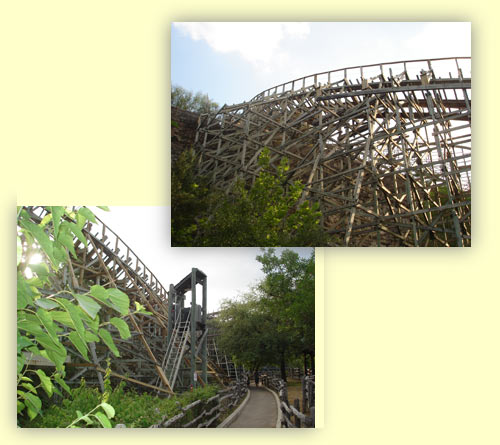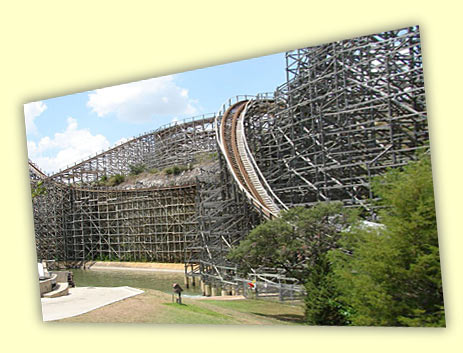Sway
by Andrew Boyd
Today, we sway. The University of Houston's College of Engineering presents this series about the machines that make our civilization run, and the people whose ingenuity created them.
The setting's almost serene. Water falling from a 200 foot stone cliff; a quiet stream surrounded by Texas Hill Country foliage; the soft twang of old country music. Problem is, every minute or so the serenity's shattered by the deafening clatter of one of the world's tallest, fastest, wooden roller coasters.

Park guests enjoy a float through Texas Hill Country
foliage as they pass under the Rattler.
The theme park's designed to give visitors an up-close look at the most frightening plunge on the coaster. It's not a simple down-and-up. It's down-and-up-and-around, with a banked turn of over 180 degrees. Wheels loudly clack as cars bounce along the coaster's track. It's called the Rattler -– the double meaning of "snake" and "shake" obviously intentional.

The Rattler's most frightening plunge.
Most frightening is how the track sways. There's tremendous energy in the coaster's cars, and the turn directs a lot of that energy sideways. The wooden structure responds by swaying as much as two to three feet back and forth before returning to equilibrium. From a distance the swaying looks like a wave traveling down the track. It's startling to watch.
Scary as it seems, swaying's an important part of engineering. Skyscrapers are designed to sway in the wind. Airplane wings are designed to sway up and down -– sometimes furiously when a plane encounters air turbulence. We want to look out the window and be comforted by a nice rigid wing. But be glad it isn't. A rigid wing would be so brittle it'd crack and fall off.
So roller coaster designers count on some sway. How much depends on the material they use: wood or steel. Steel is stronger. So steel coasters sway less than wooden ones. And steel can be shaped with higher precision. That means steel coasters can do all sorts of things their wooden counterparts can't -- loops, corkscrews, near vertical drops, hairpin turns.
Steel coasters are taller and faster, too. The world's tallest steel coaster stands 45 stories high. The tallest wooden coaster is less than half that height. Steel coasters reach speeds upwards of 125 miles-per-hour. Wooden coasters top out around 80.
Steel has so many advantages you'd think wooden coasters would be abandoned by now. But what steel coasters don't have is the same feel as wooden coasters. We glide higher and faster and more smoothly on steel. But we don't get the same sense of danger. Wooden coasters look dangerous. They sound dangerous. And they feel dangerous as they shake and rattle and bump their way down the track. Who knows when a board will snap and the coaster crash to the ground. It's not going to happen. But that doesn't stop us from thinking it just might. And that's part of the fun.
I look forward to returning to my place of "almost serenity." I like the water and the flora and the music. But most of all, I like watching the coaster track sway as the cars go flying by. It's good engineering.
I'm Andy Boyd at the University of Houston, where we're interested in the way inventive minds work.
For related episodes, see Roller Coaster, A Need for Danger, Conservation, and Stretching.
A remarkable video of the Rattler swaying, together with a discussion about whether the coaster is safe, can be found at YouTube.com. Accessed June 10, 2008.
The vantage point discussed in the essay is located on the exit to The Gully Washer at Six Flags Fiesta Texas in San Antonio. Photos above by E. A. Boyd; large photo of the Rattler (below) courtesy of Wikipedia.

The Rattler. The curve discussed in the essay is not pictured.